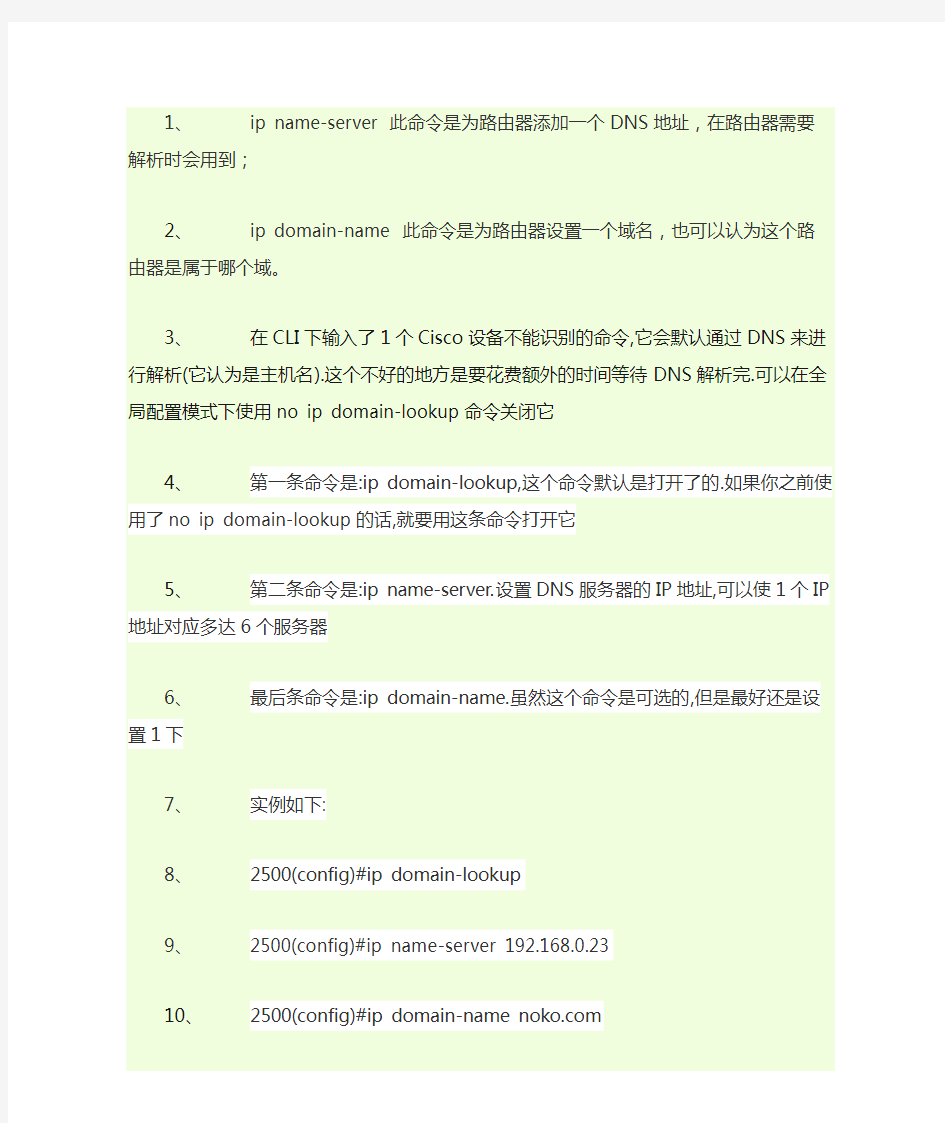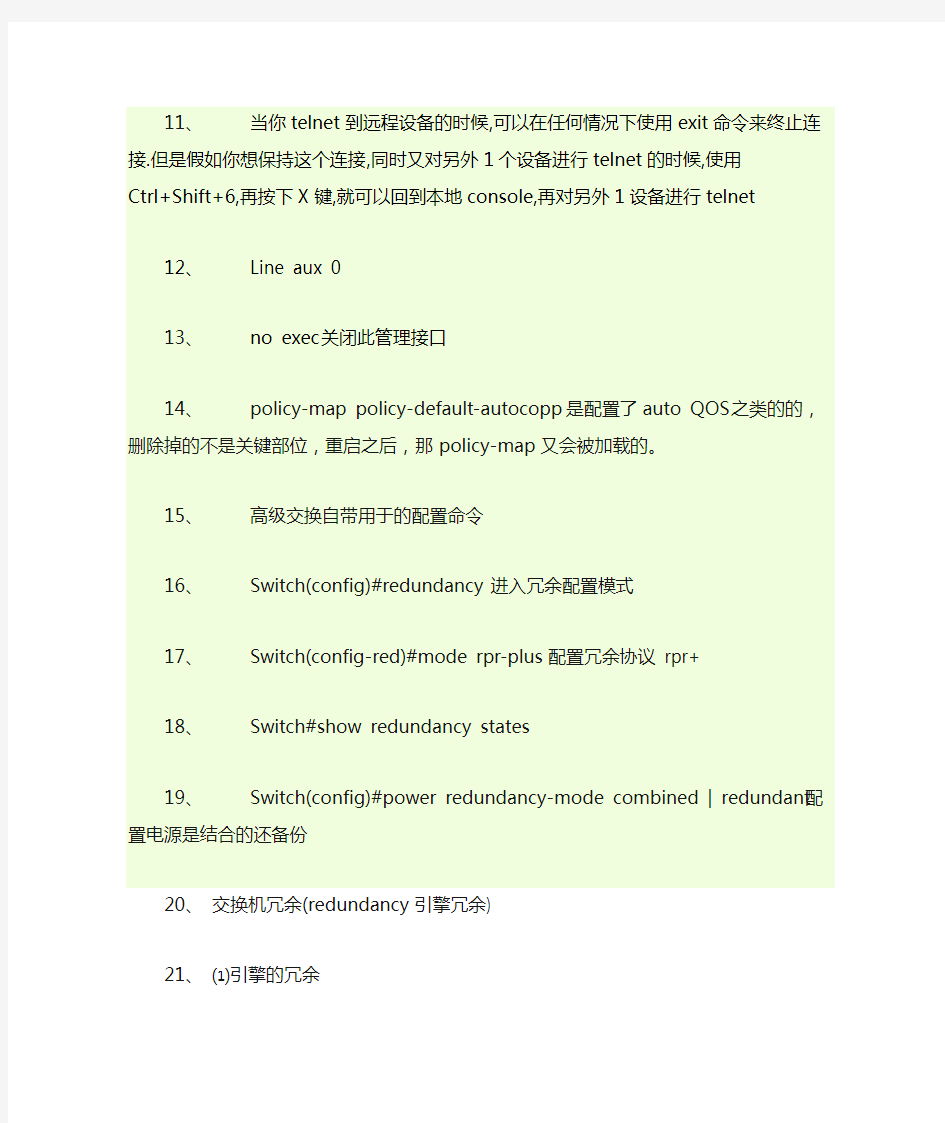

1、 ip name-server 此命令是为路由器添加一个DNS地址,在路由器需要解析时会用到;
2、ip domain-name 此命令是为路由器设置一个域名,也可以认为这个路由器是属于哪个
域。
3、在CLI下输入了1个Cisco设备不能识别的命令,它会默认通过DNS来进行解析(它认为是
主机名).这个不好的地方是要花费额外的时间等待DNS解析完.可以在全局配置模式下使用no ip domain-lookup命令关闭它
4、第一条命令是:ip domain-lookup,这个命令默认是打开了的.如果你之前使用了no ip
domain-lookup的话,就要用这条命令打开它
5、第二条命令是:ip name-server.设置DNS服务器的IP地址,可以使1个IP地址对应多达
6个服务器
6、最后条命令是:ip domain-name.虽然这个命令是可选的,但是最好还是设置1下
实例如下:
2500(config)#ip domain-lookup
2500(config)#ip name-server 192.168.0.23
2500(config)#ip domain-name https://www.doczj.com/doc/f510493526.html,
7、当你telnet到远程设备的时候,可以在任何情况下使用exit命令来终止连接.但是假如你想
保持这个连接,同时又对另外1个设备进行telnet的时候,使用Ctrl+Shift+6,再按下X键,就可以回到本地console,再对另外1设备进行telnet
8、Line aux 0
no exec关闭此管理接口
9、policy-map policy-default-autocopp是配置了auto QOS之类的的,删除掉的不是关键部位,
重启之后,那policy-map又会被加载的。
10、高级交换自带用于的配置命令
Switch(config)#redundancy 进入冗余配置模式
Switch(config-red)#mode rpr-plus 配置冗余协议 rpr+
Switch#show redundancy states
Switch(config)#power redundancy-mode combined | redundant 配置电源是结合的还备份11、交换机冗余(redundancy引擎冗余)
?引擎的冗余
①使RPR+作为冗余协议(Route Processor Redundancy Plus)
②主、备引擎同时处于启动状态,但只有主引擎工作
③主、备引擎的转换时间为30S到60S
④不支持Vlan数据库模式,但可在全局模式下用
⑤主、备引擎上运行的IOS版本要相同
⑥主、备引擎切换过程中,动态路由信息丢失,静态路由信息保留
⑦主、备引擎必须插到交换机第一个插槽和第二个插槽上
⑧不能使用分叉线缆配置主、备引擎
//配置(两个引擎都做设置)
⑨(config)#redundancy 默认第一个槽为主引擎
⑩(config-red)#mode rpr-plus
显示冗余状态:show redundancy status
?模块的冗余
提供多余的模块
?电源的冗余
?配置:(config)#power redundancy-mode combined / redundant
?Combined:多电源一起工作
?Redundant:主电源工作,备用电源不工作
//显示电源配置:show power
?风扇的冗余
12、boot-start-marker和boot-end-marker
The boot-start-marker and boot-end-marker flags, which can be seen in Cisco IOS software configuration files, are not CLI commands. These markers are written to configuration files automatically to flag the beginning and end of the boot commands (boot statements). By flagging boot statements, these markers allow the router to more reliably load Cisco IOS images during bootup
13、service counters max age
To set the statistics retrieval time, use the service counters max age command. Use the no form of this command to return to the default settings.
defaults 5 seconds简单说,就是设置设备统计状态信息的间隔时间
14、logging buffered\\将日志信息记录到内存缓冲区。内存缓冲区中的日志信息是临时
性的,设备重启或者执行特权用户命令clear logging,缓冲区中的日志信息将被清除。
如果要跟踪问题,应该将日志写到FLASH或者发送给Syslog Server。
15、loggingHostname or A.B.C.D\\将日志信息发给Syslog Server
16、logging file flash:\\将日志信息记录在FLASH上
17、logging console\\设置允许在控制台上显示的日志信息级别
18、logging monitor\\设置允许在VTY窗口(如telnet窗口)上显示的日志信息级别
19、logging trap\\设置允许发送给Syslog Server的日志信息级别
20、show users \\Display information about terminal lines显示哪个line上有用户连接
21、#terminal monitor=R1(config-line)#monitor\\第二条是指定在哪个line上开启log
缺省情况下,在VTY窗口上不允许在VTY窗口上显示日志信息。本命令只是设置当前VTY的临时属性。作为临时属性设置,它不会被永久保存。在VTY终端会话结束后,系统将采用默认设置而该临时属性设置将失效。
22、当指定设备允许显示的日志信息级别以后,等于或低于所设置值级别的日志信息
将被允许显示。
23、logging source-interface ip\\日志记录显示是从哪个ip记录的
24、service sequence-numbers\\给日志加上序号
25、service timestamps\\启用日志中的时间戳
26、system clock是基于软件的-system calendar是基于硬件的calendar不受开关机和重
起的影响,通常他只被设一次
clock set hh:mm:ss date month year\\手动设置软件时间的方法
clock update-calendar\\设置硬件时间(时钟)
ntp update-calendar\\用NTP周期性更新system calendar
clock read-calendar\\使硬件时钟来更新系统时间
clock calendar-valid\\设置本台设备为网络时钟源,一般和ntp master配合使用
ntp master\\在网络中可能有多个时钟源,设置本台设备为时钟源时定义自己的可信度,用数字代表<1-15>;当用ROUTER做NTP master,而他又不与其他外部TIME SOURCE 同步时,就表示他采用的时钟是ROUTER自己的,system calendar,这就要求他必须要authoritative
27、service tcp-keepalives-in 和service tcp-keepalives-out 命令来监控进入路由器或者
从路由器输出的TCP连接。如果路由器或交换机没有收到远程系统的响应,会自动关闭连接通常和telnet,ssh一起使用,这样做的最大好处就是可以减少路由器的负担。
28、在Linux系统下,使用finger命令,可以显示本地或远程系统中目前已登录用户的
详细信息,黑客可以利用这些信息,增大侵入系统的机会。为了系统的安全,最好禁止提供finger服务,即从/usr/bin下删除finger命令。如果要保留finger服务,应将finger 文件换名,或修改权限为只允许root用户执行finger命令。
在Cisco路由器里,为了安全起见,最好禁用该命令,no service finger
29、
思科交换机命令大全集团文件发布号:(9816-UATWW-MWUB-WUNN-INNUL-DQQTY-
思科交换机常用命令大全 1.1 用户模式与特权模式 用户模式:可以使用一些基本的查询命令 特权模式:可以对交换机进行相关的配置 进入特权模式命令:Switch>enable 退出特权模式命令:Switch#exit 启用命令查询: 时间设置:Switch#clock set 时间(自选参数,参数必须符合交换机要求) 显示信息命令:Switch#show 可选参数 注意:可以用TAB键补齐命令,自选参数为用户自定义参数,可选参数为交换机设定参数 查看交换机配置: Switch#show running-config 保存交换机配置:Switch#copy running-config startup-config Switch#wr
查看端口信息:Switch#show interface 查看MAC地址表:Switch#show mac-address-table 查看交换机CPU的状态信息:Switch#show processes 1.2 全局配置模式 进入全局配置模式:Switch#configure terminal 主机名修改:Switch(config)#hostname 主机名(自选参数) 特权模式进入密码: Switch(config)#enable secret 密码(自选参数) 取消特权模式密码:Switch(config)#no enable secret 取消主机名设置: Switch(config)#no hostname 退出配置模式: Switch(config)#exit 需要特别注意的是在配置模式中无法使用show命令,如果要使用 的话show前必须加do和空格,例如:do show * 指定根交换机命令:Switch(config)#spanning-tree vlan 自选参数(VLAN号) root primary 例如: Switch(config)#spanning-tree vlan 1 root primary
switch> 用户模式 1:进入特权模式 enable switch> enable switch# 2:进入全局配置模式 configure terminal switch> enable switch#c onfigure terminal switch(conf)# 3:交换机命名 hostname aptech2950 以aptech2950为例 switch> enable switch#c onfigure terminal switch(conf)#hostname aptch-2950 aptech2950(conf)# 4:配置使能口令 enable password cisco 以cisco为例 switch> enable switch#c onfigure terminal switch(conf)#hostname aptch2950 aptech2950(conf)# enable password cisco 5:配置使能密码 enable secret ciscolab 以cicsolab为例 switch> enable switch#c onfigure terminal switch(conf)#hostname aptch2950 aptech2950(conf)# enable secret ciscolab 6:设置虚拟局域网vlan 1 interface vlan 1 switch> enable switch#c onfigure terminal switch(conf)#hostname aptch2950 aptech2950(conf)# interface vlan 1 aptech2950(conf-if)#ip address 192.168.1.1 255.255.255.0 配置交换机端口ip 和子网掩码 aptech2950(conf-if)#no shut 是配置处于运行中aptech2950(conf-if)#exit aptech2950(conf)#ip default-gateway 192.168.254 设置网关地址 7:进入交换机某一端口 interface fastehernet 0/17 以17端口为例switch> enable switch#c onfigure terminal switch(conf)#hostname aptch2950 aptech2950(conf)# interface fastehernet 0/17 aptech2950(conf-if)#
Cisco配置命令汇总 第一章 命令作用简便拼法 show version 检验路由器启动过程①sh ve enable 进入特权执行模式en conf t 进入全局配置模式conf (enter两次)在全局配置模式下Router(config)# hostname name 命名路由器ho +name enable secret password 设置使能密码ena s line console 0 进入console配置模式li co (config-line)#password password 配置console口密码pa +name config-line)#login 登陆logi line vty 0 4 设置远程控制接口限制li v config-line)#password 设置远程控制登陆密码pa +password (config-line)#login 登陆logi interface type number (such as f0/0 se0/0/0) 进入接口配置模式int + (such as f0/0 se0/0/0) config-if)# ip address address mask 设置接口ip地址和子网掩码ip add(删除前面加no)config-if)#description 设置描述内容de config-if)#no shutdown 开启no sh(关闭shutdown)在特权模式下(Router#) copy running-config startup-config 保存路由器更改cop run sta show running-config 查看路由器运行文件sh run show ip route 查看路由表sh ip rou show ip interface brief 查看各个接口状态sh ip int br show interfaces 查看各个接口的详细信息sh int clock rate+number 配置串行接口上的时钟信号cl ra+number show controllers+接口 (s0/0/0) 确定路由器接口连接的电缆sh co debug ip routing 启动调试功能de ip rou
CISCO命令全集-思科命令汇总 视图模式介绍: 普通视图router> 特权视图router# /在普通模式下输入enable 全局视图router(config)# /在特权模式下输入config t 接口视图router(config-if)# /在全局模式下输入int 接口名称例如int s0或int e0 路由协议视图router(config-route)# /在全局模式下输入router 动态路由协议名称 1、基本配置: router>enable /进入特权模式 router#conf t /进入全局配置模式 router(config)# hostname xxx /设置设备名称就好像给我们的计算机起个名字 router(config)#enable password /设置特权口令 router(config)#no ip domain lookup /不允许路由器缺省使用DNS解析命令 router(config)# Service password-encrypt /对所有在路由器上输入的口令进行暗文加密 router(config)#line vty 0 4 /进入设置telnet服务模式 router(config-line)#password xxx /设置telnet的密码 router(config-line)#login /使能可以登陆 router(config)#line con 0 /进入控制口的服务模式 router(config-line)#password xxx /要设置console的密码 router(config-line)#login /使能可以登陆 2、接口配置: router(config)#int s0 /进入接口配置模式serial 0 端口配置(如果是模块化的路由器前面加上槽位编号,例如serial0/0 代表这个路由器的0槽位上的第一个接口) router(config-if)#ip add xxx.xxx.xxx.xxx xxx.xxx.xxx.xxx /添加ip 地址和掩码
实训目的: (1)学习和掌握科路由器的配置方式和要求。 (2)学习和掌握科路由器的工作模式分类、提示符、进入方式。1、路由器的配置方式 ①超级终端方式。该方式主要用于路由器的初始配置,路由器不需要IP地址。基本方法是:计算机通过COM1/COM2口和路由器的Console口连接,在计算机上启用“超级终端”程序,设置“波特率:9600 ,数据位:8,停止位:1,奇偶校验: 无,校验:无”即可。常用 ②Telnet方式。该方式配置要求路由器必须配置了IP地址。基本方法是:计算机通过网卡和路由器的以太网接口相连,计算机的网卡和路由器的以太网接口的IP地址必须在同一网段。常用 ③其他方式:AUX口接MODEM,通过电话线与远方运行终端仿真软件的微机;通过Ethernet上的TFTP服务器;通过Ethernet上的SNMP网管工作站。 2、路由器的工作模式 在命令行状态下,主要有以下几种工作模式: ①一般用户模式。主要用于查看路由器的基本信息,只能执行少数命令,不能对路由 器进行配置。提示符为:Router>;进入方式为:Telnet或Console ②使能(特权)模式。主要用于查看、测试、检查路由器或网络,不能对接口、路由 协议进行配置。提示符为:Router#;进入方式为:Router>enable。 ③全局配置模式。主要用于配置路由器的全局性参数。提示符为:Router(config)#; 进入方式为:Router#config ter。 ④全局模式下的子模式。包括:接口、路由协议、线路等。其进入方式和提示符如下: Router(config)#ineterface e0 //进入接口模式 Router(config-if)#//接口模式提示符 Router(config)#rip //进入路由协议模式 Router(config-router)# //路由协议模式 Router(config)#line con 0 //进入线路模式
CISCO 命令 1:进入特权模式 enable switch> enable switch# 2:进入全局配置模式 configure terminal switch> enable switch#c onfigure terminal switch(conf)# 3:交换机命名 hostname aptech2950 以aptech2950为例 switch> enable switch#c onfigure terminal switch(conf)#hostname aptch-2950 aptech2950(conf)# 4:配置使能口令 enable password cisco 以cisco为例 switch> enable switch#c onfigure terminal switch(conf)#hostname aptch2950 aptech2950(conf)# enable password cisco 5:配置使能密码 enable secret ciscolab 以cicsolab为例 switch> enable switch#c onfigure terminal switch(conf)#hostname aptch2950 aptech2950(conf)# enable secret ciscolab 6:设置虚拟局域网vlan 1 interface vlan 1 switch> enable switch#c onfigure terminal switch(conf)#hostname aptch2950 aptech2950(conf)# interface vlan 1 aptech2950(conf-if)#ip address 192.168.1.1 255.255.255.0 配置交换机端口ip和子网掩码aptech2950(conf-if)#no shut 是配置处于运行中 aptech2950(conf-if)#exit aptech2950(conf)#ip default-gateway 192.168.254 设置网关地址 7:进入交换机某一端口 interface fastehernet 0/17 以17端口为例 switch> enable switch#c onfigure terminal switch(conf)#hostname aptch2950 aptech2950(conf)# interface fastehernet 0/17 aptech2950(conf-if)#
思科交换机常用命令大全 1.1 用户模式与特权模式 用户模式:可以使用一些基本的查询命令 特权模式:可以对交换机进行相关的配置 进入特权模式命令:Switch>enable 退出特权模式命令:Switch#exit 启用命令查询:? 时间设置:Switch#clock set 时间(自选参数,参数必须符合交换机要求) 显示信息命令:Switch#show 可选参数 注意:可以用TAB键补齐命令,自选参数为用户自定义参数,可选参数为交换机设定参数 查看交换机配置: Switch#show running-config 保存交换机配置:Switch#copy running-config startup-config Switch#wr 查看端口信息:Switch#show interface 查看MAC地址表:Switch#show mac-address-table 查看交换机CPU的状态信息:Switch#show processes 1.2 全局配置模式 进入全局配置模式:Switch#configure terminal
主机名修改:Switch(config)#hostname 主机名(自选参数) 特权模式进入密码: Switch(config)#enable secret 密码(自选参数) 取消特权模式密码:Switch(config)#no enable secret 取消主机名设置: Switch(config)#no hostname 退出配置模式: Switch(config)#exit 需要特别注意的是在配置模式中无法使用show命令,如果要使用 的话show前必须加do和空格,例如:do show * 指定根交换机命令:Switch(config)#spanning-tree vlan 自选参数(VLAN号)root primary 例如: Switch(config)#spanning-tree vlan 1 root primary 需要注意的是:设置根交换机是基于VLAN的 关闭生成树协议命令:Switch(config)#no spanning-tree vlan 自选参数(VLAN 号) 例如: Switch(config)#no spanning-tree vlan 1 1.3 接口配置模式 进入接口配置模式:Switch(config)#interface 端口名称(可选参数) 启用端口:Switch(config-if)#no shutdown 停用端口:Switch(config-if)#shutdown 进入同种类型多端口配置:Switch(config)# interface range fastethernet 0/1-5 进入不同类型多端口配置:Switch(config)#interface range fastethernet 0/1-5,gigabitethernet 0/1-2
思科交换机基本配置实例讲解
目录 1、基本概念介绍............................................... 2、密码、登陆等基本配置....................................... 3、CISCO设备端口配置详解...................................... 4、VLAN的规划及配置........................................... 4.1核心交换机的相关配置..................................... 4.2接入交换机的相关配置..................................... 5、配置交换机的路由功能....................................... 6、配置交换机的DHCP功能...................................... 7、常用排错命令...............................................
1、基本概念介绍 IOS: 互联网操作系统,也就是交换机和路由器中用的操作系统VLAN: 虚拟lan VTP: VLAN TRUNK PROTOCOL DHCP: 动态主机配置协议 ACL:访问控制列表 三层交换机:具有三层路由转发能力的交换机 本教程中“#”后的蓝色文字为注释内容。 2、密码、登陆等基本配置 本节介绍的内容为cisco路由器或者交换机的基本配置,在目前版本的cisco交换机或路由器上的这些命令是通用的。本教程用的是cisco的模拟器做的介绍,一些具体的端口显示或许与你们实际的设备不符,但这并不影响基本配置命令的执行。 Cisco 3640 (R4700) processor (revision 0xFF) with 124928K/6144K bytes of memory. Processor board ID 00000000 R4700 CPU at 100MHz, Implementation 33, Rev 1.2
视图模式介绍: 普通视图ro u ter>特权视图router#/ 在普通模式下输入en abl e 全局视图rou ter(con fi g)#/ 在特权模式下输入con figt 接口视图rou ter(con fi g-i f)#/在全局模式下输入in t 接口名称例如in ts0或 in te0路由协议视图 ro uter(con fi g-rou te )#/ 在全局模式下输入ro u ter动态路由协议名称 1、基本配置: ro uter>en abl e/进入特权模式 ro uter#con ft/ 进入全局配置模式 ro uter(con fi g)#ho stn a mex xx/设置设备名称就好像给我们的计算机起个名字 ro uter(con fi g)#en abl epasswo rd/设置特权口令ro uter(con fi g)#n oi pdo ma inl ook up/不允许路由器缺省使用DN S解析命令 ro uter(con fi g)#Serv icepa sswo rd-en crypt/对所有在路由器上输入的口令进行暗文加密
ro uter(con fi g)#li n ev ty04/进入设置teln et服务模式ro uter(con fi g-l in e)#passwo rdx xx/设置teln et 的密码ro uter(con fi g-l in e)#lo gi n/使能可以登陆 ro uter(con fi g)#li n econ0/进入控制口的服务模式 ro uter(con fi g-l in e)#passwo rdx xx/要设置con so l e 的密码rou ter(con fi g-lin e)#lo gi n/使能可以登陆 2、接口配置: ro uter(con fi g)#in ts0/ 进入接口配置模式seria l0 端口配置(如果是模块化的路由器前面加上槽位编号,例如seria l0/0代表这个路由器的0 槽位上的第一个接口) ro uter(con fi g-i f)#ipa ddxx x.xxx.x xx.x xxx xx.x xx.xx x.xx x/添加ip地址和掩码 ro uter(con fi g-i f)#enca hdl c/ppp捆绑链路协议hdlc或者ppp思科缺省串口封装的链路层协议是 H DLC所以在sho wru n配置的时候接口上的配置没有,如果要封装为别的链路层协议例如 PPP/FR/X25就是看到接口下的en cappp 或者en ca fr ro uter(con fi g)#in tl oo pba ck/建立环回口(逻辑接口)模拟不同的本机网段
一 switch> 用户模式 1:进入特权模式enable switch> enable switch# 2:进入全局配置模式configure terminal switch> enable switch#c onfigure terminal switch(conf)# 3:交换机命名hostname aptech2950 以aptech2950为例 switch> enable switch#c onfigure terminal switch(conf)#hostname aptch-2950 aptech2950(conf)# 4:配置使能口令enable password cisco 以cisco为例 switch> enable switch#c onfigure terminal switch(conf)#hostname aptch2950 aptech2950(conf)# enable password cisco 5:配置使能密码enable secret ciscolab 以cicsolab为例 switch> enable switch#c onfigure terminal switch(conf)#hostname aptch2950 aptech2950(conf)# enable secret ciscolab 6:设置虚拟局域网vlan 1 interface vlan 1 switch> enable switch#c onfigure terminal switch(conf)#hostname aptch2950 aptech2950(conf)# interface vlan 1 aptech2950(conf-if)#ip address 配置交换机端口ip和子网掩码 aptech2950(conf-if)#no shut 是配置处于运行中aptech2950(conf-if)#exit aptech2950(conf)#ip default-gateway 设置网关地址 7:进入交换机某一端口interface fastehernet 0/17 以17端口为例switch> enable switch#c onfigure terminal switch(conf)#hostname aptch2950 aptech2950(conf)# interface fastehernet 0/17 aptech2950(conf-if)# 8:查看命令show switch> enable
思科交换机命令大全 (一) 序号/类别基于ios的交换机命令基于CLI的交换机命令 1.设置主机名/系统名switch(config)# hostname "hostname" switch(enable) set system name name-string 2.设置登录口令switch(config)# enable password level 1 password switch(enable) set password switch(enable) set enalbepass 3.设置远程访问switch(config)# inte***ce vlan 1 switch(config-if)# ip address ip-address netmask switch(config-if)# ip default-gateway ip-address switch(enable) set inte***ce sc0 ip-address netmask broadcast-address switch(enable) set inte***ce sc0 vlan switch(enable) set ip route default gateway 4.启用和浏览CDP信息switch(config-if)# cdp enable switch(config-if)# no cdp enable switch(enable) set cdp {enable|disable} module/port 5.查看Cisco邻接设备的CDP通告switch# show cdp inte***ce [type modle/port] switch# show cdp neighbors [type module/port] [detail] switch(enable) show cdp neighbors[module/port] [vlan|duplex|capabilities|detail] 6.端口描述switch(config-if)#description escription-string switch(enable)set port name module/number description-string 7.设置端口速度switch(config-if)# speed{10|100|auto} switch(enable) set port speed moudle/number {10|100|auto} switch(enable) set port speed moudle/number {4|16|auto} 8.设置以太网的链路模式switch(config-if)# duplex {auto|full|half} switch(enable) set port duplex module/number {full|half 9.配置静态VLAN switch# vlan database switch(vlan)# vlan vlan-num name vla switch(vlan)# exit switch# configure teriminal switch(config)#inte***ce inte***ce module/number switch(config-if)# switchport mode access switch(config-if)# switchport access vlan vlan-num switch(config-if)# end switch(enable) set vlan vlan-num [name name] switch(enable) set vlan vlan-num mod-num/port-list 10.配置VLAN中继线switch(config)# inte***ce inte***ce mod/port switch(config-if)# switchport mode trunk switch(config-if)#switchport trunk encapsulation {isl|dotlq} switch(config-if)# switchport trunk allowed vlan remove vlan-list switch(config-if)# switchport trunk allowed vlan add vlan-list switch(enable)set trunk module/port [on|off|desirable|auto|nonegotiate] Vlan-range [isl|dotlq|dotl0|lane|negotiate] 11.配置VTP管理域switch# vlan database
思科路由器基本配置与常用配置命令(simple for CCNA) 启动接口,分配IP地址: router> router> enable router# router# configure terminal router(config)# router(config)# interface Type Port router(config-if)# no shutdown router(config-if)# ip address IP-Address Subnet-Mask router(config-if)# ^z 配置RIP路由协议:30秒更新一次 router(config)# router rip router(config-if)# network Network-Number router(config-if)# ^z 配置IGRP路由协议:90秒更新一次 router(config)# router igrp AS-Number router(config-if)# network Network-Number router(config-if)# ^z配置Novell IPX路由协议:Novell RIP 60秒更新一次 router(config)# ipx routing [node address] router(config)# ipx maximum-paths Paths router(config)# interface Type Port router(config-if)# ipx network Network-Number [encapsulation encapsulation-type] [secondary] router(config-if)# ^z配置DDR: router(config)# dialer-list Group-Number protocol Protocol-Type permit [list ACL-Number] router(config)# interface bri 0 router(config-if)# dialer-group Group-Number router(config-if)# dialer map Protocol-Type Next-Hop-Address name Hostname Telphone-Number router(config-if)# ^z配置ISDN: router(config)# isdn swith-type Swith-Type router(config-if)# ^z 配置Frame Relay: router(config-if)# encapsulation frame-relay [cisco | ietf ] router(config-if)# frame-relay lmi-type [ansi | cisco | q933a ] router(config-if)# bandwidth kilobits router(config-if)# frame-relay invers-arp [ Protocol ] [dlci ] router(config-if)# ^z配置标准ACL: router(config)# access-list Access-List-Number [ permit | deny ] source [ source-mask ] router(config)# interface Type Port router(config-if)# ip access-group Access-List-Number [ in | out ] router(config-if)# ^z配置扩展ACL: router(config)# access-list Access-List-Number [ permit | deny ] [ Protocol | Protocol-Number ] source source-wildcard [ Source-Port ] destination destination-wildcard [ Destination-Port ] [ established ]
【最新整理,下载后即可编辑】 Cisco三层交换机配置命令及解释 (2011-07-11 08:54:50) 分类:IT资讯 标签: cisco 杂谈 基本配置 S> enable 进入特权模式 S# configure terminal 进入全局配置模式 S(config)# hostname name 改变交换机名称 S(config)# enable password level level_# password 设置用户口令(level_#=1)或特权口令(level_#=15) S(config)# line console 0 进入控制台接口 S(config-line)# password console_password 接上一条命令,设置控制台口令 S(config)# line vty 0 15 进入虚拟终端 S(config-line)# password telnet_password 接上一条命令,设置Telnet口令 S(config-line)# login 允许Telnet登录 S(config)# enable password|secret privilege_password 配置特权口令(加密或不加密) S(config)# interface ethernet|fastethernet|gigabitethernet slot_#/port_# 进入接口子配置模式 S(config-if)# [no] shutdown 关闭或启用该接口(默认启用) S(config)# ip address IP_address sunbet_mask 指定IP地址 S(config)# ip default-gateway router's_IP_address 指定哪台路由器地址为默认网关 S# show running-config 查看当前的配置 S# copy running-config startup-config 将RAM中的当前配置保存到NVRAM中
端口速度:设置端口速度为:100Mbps/s 半双工模式 Switch# configure terminal Switch(config)# interface range gigabitethernet0/1 - 2 Switch(config-if-range)# speed 100 Switch(config-if)# duplex half 定义端口聚合并存储到NVRAM:定义名称为enet_list的端口组。 Switch# configure terminal Switch(config)# define interface-range enet_list gigabitethernet0/1 - 2 Switch(config)# end Switch# show running-config | include define Switch# define interface-range enet_list gigabitethernet0/1 – 2 Switch# configure terminal Switch(config)# no define interface-range enet_list Switch(config)# end Switch# show run | include define Switch# 设置端口类型: Switch(config-if)media-type auto-select | rj45 | sfp Switch#show interfaces interface-id transceiver properties
Cisco交换机常用配置命令 CISCO交换机基本配置 switch>ena 進入特权模式 switch#erasenvram 全部清除交换机的所有配置 switch#reload 重新启动交换机(初始提示符为switch> ) ------------------------------------------------------------------------------------ CISCO交换机基本配置:Console端口连接 用户模式hostname>; 特权模式hostname(config)# ; 全局配置模式hostname(config-if)# ; 交换机口令设置: switch>enable ;进入特权模式 switch#config;进入全局配置模式 switch(config)#hostname cisco ;设置交换机的主机名 switch(config)#enable secret csico1 ;设置特权加密口令 switch(config)#enable password csico8 ;设置特权非密口令 switch(config)#line console 0 ;进入控制台口 switch(config-line)#line vty 0 4 ;进入虚拟终端 switch(config-line)#login ;虚拟终端允许登录 switch(config-line)#password csico6 ;设置虚拟终端登录口令csico6 switch#write 保存配置設置 switch#copy running-config startup-config 保存配置設置,與write一樣switch#exit;返回命令 配置终端过一会时间就会由全局配置模式自动改为用户模式,将超时设置为永不超时 switch#conf t switch(config)#line con 0 switch(config-line)#exec-timeout 0 --------------------------------------------------------------------------------- 交换机显示命令: switch#write;保存配置信息 switch#showvtp;查看vtp配置信息 switch#show run ;查看当前配置信息 switch#showvlan;查看vlan配置信息 switch#showvlan name vlan2 switch#show interface ;查看端口信息
1.设置主机名/系统名 IOS:switch(config)# hostname "hostname" CLI:switch(enable) set system name name-string 2.设置登录口令 IOS:switch(config)# enable password level 1 password CLI:switch(enable) set password switch(enable) set enalbepass 3.设置远程访问 IOS:switch(config)# interface vlan 1 switch(config-if)# ip address ip-address netmask switch(config-if)# ip default-gateway ip-address CLI:switch(enable) set interface sc0 ip-address netmask broadcast-address switch(enable) set interface sc0 vlan switch(enable) set ip route default gateway 4.启用和浏览CDP信息 IOS:switch(config-if)# cdp enable switch(config-if)# no cdp enable CLI:switch(enable) set cdp {enable|disable} module/port 5.查看Cisco邻接设备的CDP通告 IOS:switch# show cdp interface [type modle/port] switch# show cdp neighbors [type module/port] [detail] CLI:switch(enable) show cdp neighbors[module/port] [vlan|duplex|capabilities|detail]
路由器实验: router> enable 从用户模式进入特权模式 router# disable or exit 从特权模式退出到用户模式 router# show sessions 查看本机上的TELNET会话router# disconnect 关闭所有的TELNET会话 router# show users 查看本机上的用户 router# erase startupconfig 删除NVRAM中的配置 router# reload 重启路由器 router# config terminal 从用户模式进入特权模式 router(config)# hostname rl 配置用户名为rl router(config)# #banner welcome# 配置开机话语
router# show controllers serial0 查看串口0的物理层信息(主要是查看DTE/DCE)router# show ip interface 查看端口的IP配置信息 router# show hosts 查看主机表 end or ctrl+z 从各种配置模式退到特权模式 rl(config)# no ipdomainlookup 关闭动态域名解析 rl(config)# ipdomainlookup 打开动态域名解析 rl(config)# ipnameserver 202.106.0.20 打开动态域名解析之后便可以指定DNS服务rl(config)# interface serial 0 进入serial 0的接口配置模式 rl(configif)# no shutdown 路由器出厂默认所有端口关闭,使用此命令使它们打开rl(configif)# encapsulation ppp 封装ppp rl(configif)# clockrate 64000 如果是DCE使需要设置时钟速率,如果是DTE使不必设置